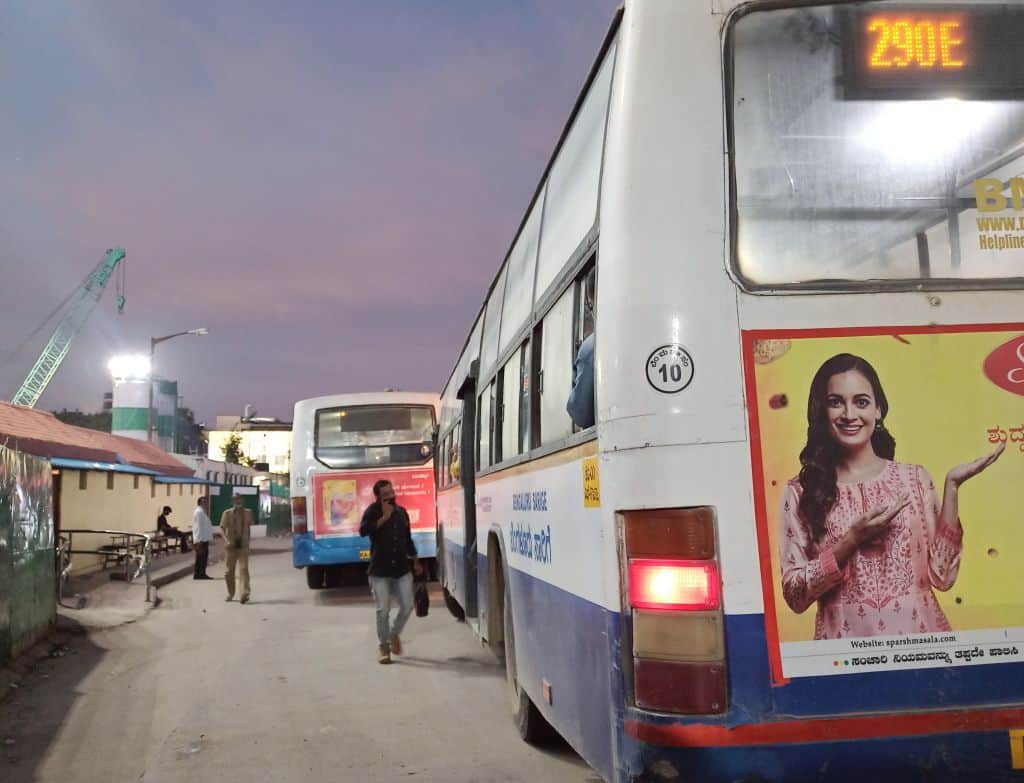Everyday, around 40 lakh passengers use the bus and about five lakh people travel by Namma Metro. Yet, there is some hesitancy, in Bengaluru, to choose buses and metro over cars and bikes. To understand why this is the case and how it can change, Citizen Matters, Bengaluru, organised a webinar ‘Why not public transport?’
The panellists included Srinivas Alavilli, Fellow, Integrated Transport and Road Safety, World Resources Institute (WRI) India; Shreya Satish Mokhashi, Assistant Urban Planner at Directorate of Urban Land Transport (DULT); Jayenkumar Desai, Head of Strategy and Transformation VMware Software India Pvt Ltd; and Lalithamba BV, a citizen of Bengaluru and an advocate of sustainable transport. Meera K, Trustee Oorvani Foundation, was the moderator.
The discussion centred around questions like what needs to change for car and bike users to shift to public transport? Is it due to poor last mile connectivity? Is it because of convenience? Or due to inadequate public transport connectivity? What needs to be done to encourage public transport among citizens?
Suggestions by panellists
Srinivas pointed out that traffic would reduce by 40% if public transport was used. He added that Bengaluru Political Action Committee (B.PAC) and WRI have launched the Personal2Public (P2P) campaign to encourage the IT corridor to switch to public transport twice a week. “With more metro connectivity and buses being released in the city, the priority would be to focus on those who are extensively dependent on personal commute. We need conversion there,” he says.

However, inadequate public transport connectivity is a cause for concern. As per an OpenCity report, seven constituencies, which comprises 25% of the city, has no metro stations. In many areas, the nearest bus stops are more than two kilometres.“We do not expect the metro to reach every ward, however we are trying to make facilities that will connect to the metro,” Shreya observed. She adds that DULT is trying to inculcate the 666 criteria in the transit-oriented development (TOD) policy. ( DULT defines a TOD Zone as an area falling broadly within 1,000 meters of a station along existing and proposed mass transit systems including Namma Metro, Suburban Rail, and large public transport hubs such as Traffic Transit Management Centres [TTMC]).
- Core TOD zone- Reach transit zones by walking for six minutes
- Standard TOD zone- Reach transit zones by 6 mins cycling/ 12 minutes walking
- Enhancing bus systems – for those outside TOD zones for last mile connectivity
Jayen spoke about corporate responsibility in enabling employees to switch to public transport. He specifies that in addition to launching EV vehicles, P2P, and spreading awareness, which a few companies are following, other immediate actions that should be undertaken. “Companies can promote carpooling, which is the easiest to implement and incentivise employees for opting for sustainable transport. This will make more people switch to public transport.”
Lalithamba, a citizen who uses public transport, agreed with Jayen’s plan for carpooling. She has used it extensively and urges for more such initiatives. She adds that if basic infrastructure like decent footpaths and good connectivity is put in place, it will encourage people to get out of their comfort zones.
Jayen emphasised that millennials and Gen Z are tired of personal commute due to lack of interpersonal interaction, and will easily opt for public services, if made easier to access. Shreya also suggested that to enhance the future of public transport, awareness among the youth must be created. In essence, the panellists agreed that better first and last mile connectivity should be ensured.
Read more: Explainer: Urban planning measures that can reduce traffic and ease commute
Citizens’ opinions
Based on the discussions, citizens shared some concerns and suggestions for improving Bengaluru’s transport system.
Concerns:
- Congested road space due to haphazard parking of vehicles and hawkers occupying footpaths
- Issues with last mile connectivity and lack of seamless public transport connection across the city
- Narrow roads make navigation difficult for public transport
- Lack of pedestrian safety, due to unsafe crossings, broken footpaths. This makes people use cars and bikes for short distance travel
- Bus timings are not fixed as per schedule, which makes it difficult to plan commute
- Delay in implementation of projects, such as completing laying of metro lines, introducing more buses etc.
Suggestions:
- A unified travel card/app for all public transport would be beneficial in the long run
- Reduce congestion by relocating hawkers and organising street parking
- Provide more feeder buses, shared autos and loop buses to connect to metro transits for last mile connectivity
- Introduce bus lanes on high density routes for smooth travel
- Ensure proper footpaths, pedestrian crossings, so people do not opt for private vehicles to commute shorter distances
- Add relevant information in bus stops/shelters about bus frequency
- Introduce paid street parking. Provide annual parking passes to avoid congestion
- Introduce double decker buses, as they are appealing and can accommodate more passengers
- Develop Namma BMTC app adequately
- Encourage corporates to run their own buses for employees, a facility which has been stopped in several places. Incentivise carpooling, where people can share one car to their workplaces
- Take inspiration from international workplaces to incentivise employees who switch to sustainable transport
Watch the full discussion: